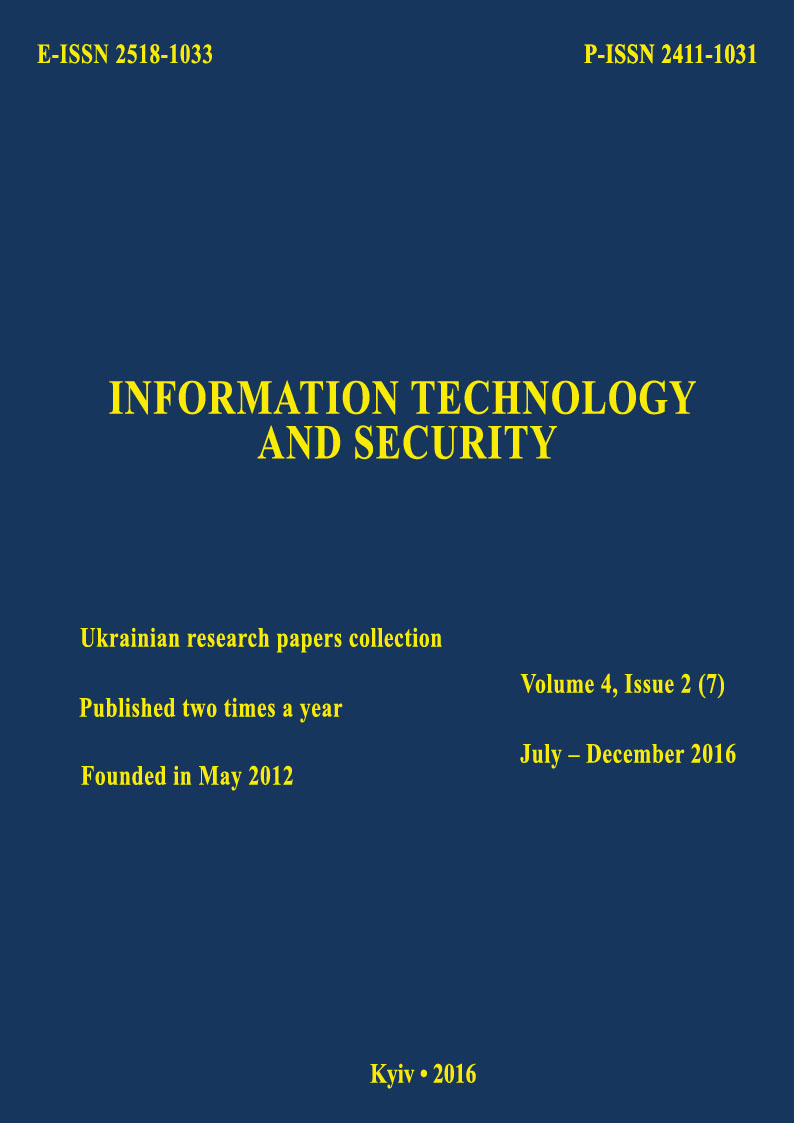Statistical reliability of noise hindrance for ensuring protection against leakage of information through technical channels
DOI:
https://doi.org/10.20535/2411-1031.2016.4.2.109981Keywords:
Information, security, risk, information leakage, technical channel of leakage, noise hindrance, statistical reliability.Abstract
The statistical reliability of the noise hindrance that used to protect the information against leakage through technical channels is grounded in this paper. It is a component of technical reliability of information security system and it is defined as the probability that the statistical characteristics of the studied noise hindrance will not go beyond the permissible limits. The use of this noise hindrance in security systems will guarantee to act with an effective spectral density, which will provide the necessary probability of errors and other security indicators in channel of leakage. Assessment of the effective spectral density is carried out regarding the decisive scheme of the ideal receiver, which is built on the criterion of Kotelnikov and it includes the following steps: determination function of correlation of noise process, the verification process on stationary and ergodicity, its verification on the normal distribution and the calculation of the sought effective spectral density. Determining the function of correlation of noise process is carried out with so-called “margin” on the error for the worst case from the point of view of security. Verification of the process on the temporal homogeneity and ergodic performed using Slutsky conditions. The resulting statistical reliability of the noise hindrance is the product of the statistical reliability of the estimates at all stages. It is an indicator of the reliability guarantee and component information security system as a whole.
References
International Organization for Standardization. (2013, Okt. 01). ISO/IEC 27001, Information technology. Security techniques. Information security management. Requirements. [Online]. Available: https://www.iso.org/standard/54534.html. Accessed on: Aug., 28, 2016.
International Organization for Standardization. (2013, Okt. 01). ISO/IEC 27002, Information technology. Security Techniques. Code of practice for information security controls. [Online]. Available: https://www.iso.org/standard/54533.html. Accessed on: Aug., 28, 2016.
G.A. Buzov, S.V. Kalinin, and A.V. Kondratev, Protection Information Against Leakage Through Technical Channels. Moscow, Russia: Goryachaya liniya, Telekom, 2005.
S.V Lenkov, D.A. Peregudov and V.A. Khoroshko, Methods and Means of Information Protection. Volume I.Unauthorized Receiving the Information. Kyiv, Ukraine: Arii, 2008.
G. Kuhn, Compromising Emanations: Eavesdropping Risks of Computer Displays. Technical Report. [Online]. Available: http://www. cl. cam. ас. uk/techreports. Accessed on: Aug., 28, 2016.
Ueli M. Maurer, “A Universal Statistical Test for Random Bit Generators”, Journal of Cryptology, vol. 5, iss. 2, pp. 89-105, January 1992.
doi: 10.1007/BF00193563.
S.O. Ivanchenko, “Justification Risk Security of Information From Leakage by Technical Channels”, Legal, Regulatory and Metrological Support of Information in Ukraine, no.1 (31), pp. 9-13, 2016.
S.I. Baskakov, Radio Technical Circuits and Signals. Moscow, Russia: Vysshaia shkola, 1988.
D L Burachenko et al., Common Theory of Communication. Moscow, Russia: VAS, 1970.
S.O Ivanchenko, V.O. Khoroshko, O.V. Ghavrylenko, and O.M. Kulinich. ”The method of diagnosing noise hindrances to provide information security from leakage technical channels”, Zahist ìnformacìi: sbornyk nauchnykh trudov. Kyiv, NAU, Release 22, p. 74-86, 2015.
J. Bendat, and A. Pirsol. Applied Analysis of Random Data. Moscow, Russia: Mir, 1989.
Downloads
Published
How to Cite
Issue
Section
License
Copyright (c) 2020 Collection "Information technology and security"

This work is licensed under a Creative Commons Attribution 4.0 International License.
The authors that are published in this collection, agree to the following terms:
- The authors reserve the right to authorship of their work and pass the collection right of first publication this work is licensed under the Creative Commons Attribution License, which allows others to freely distribute the published work with the obligatory reference to the authors of the original work and the first publication of the work in this collection.
- The authors have the right to conclude an agreement on exclusive distribution of the work in the form in which it was published this anthology (for example, to place the work in a digital repository institution or to publish in the structure of the monograph), provided that references to the first publication of the work in this collection.
- Policy of the journal allows and encourages the placement of authors on the Internet (for example, in storage facilities or on personal web sites) the manuscript of the work, prior to the submission of the manuscript to the editor, and during its editorial processing, as it contributes to productive scientific discussion and positive effect on the efficiency and dynamics of citations of published work (see The Effect of Open Access).

